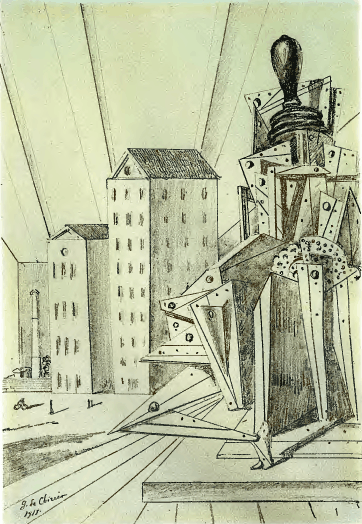
Description of the picture:
The great metaphysician is de Chirico. 1924.110×80
The war, the long months spent with fighters in the infirmary in the Bella del Seminario near Ferrara – all this could not but affect the work of de Chirico. A wounded fighter, often coming to the artist in a dream, is transformed in his work into an image-mannequin.
"Majestic metaphysician" – this is not only an image of a person deformed by war – such is the vision of a person by a master. De Chirico wrote several versions of this picture (the first of them in 1917). The composition, faithfully built by the artist, is based on the Renaissance atmosphere of Italian cities with their catchy color. The creator depicts twilight, reminiscent of the northern lights, so the picture takes on the features of unreality. Against the backdrop of a dark, full of dramatic sky rises stately figure metaphysics. His outfit is made up of draperies and wood objects of geometric shapes – triangles, boxes, frames, boards, etc. The great metaphysician appears as a giant alien from the future, a Nietzschean superman or Iron Man, described by the artist’s brother in the book "Realta dorata". The figure of Metaphysics rises in the middle of a deserted square like an ancient totem. It is lonely, a stranger in the surrounding landscape – an anachronism, an alien from another era. De Chirico wrote about this in 1929 in his "Abdomomeros": "Considering the weight, the more pragmatic and materialistic orientation of our civilization (…) does not seem paradoxical the development of such a social system in which there will be no place under the sun for a person living a spiritual life. A writer, thinker, dreamer, poet, philosopher (…) will become anachronistic figures, doomed to extinction, disappearance from the face of the earth, like ichthyosaurs and mammoths".
Before starting to work with paints, de Chirico performs a series of preliminary sketches, allowing him to elaborate on the topic. These drawings, verified in composition and elegant in execution, may well be called independent graphic works. The first sketch on the canvas is very sketchy, these are just general outlines of the future picture. Then the artist makes several more drawings, more detailed, where he draws all the elements that should appear on the canvas. In this series of sketches, the background and surroundings of the main motive are gradually changing.
 "
"